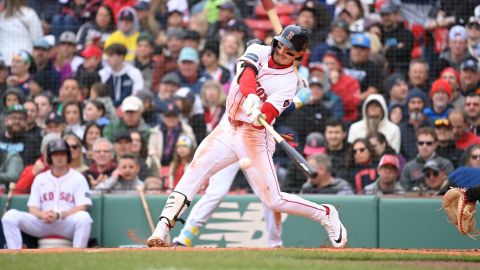The Drew Pomeranz era in Boston begins Wednesday night.
The 27-year-old pitcher will make his Red Sox debut a few days after Boston acquired him from the San Diego Padres in exchange for prized pitching prospect Anderson Espinoza.
For that reason alone — that the price to acquire Pomeranz was a top prospect — the left-hander will face a good deal of pressure during his Red Sox tenure. That pressure will intensify if Espinoza develops the way many believe he’s capable of developing.
That being said, there’s plenty of reason for Red Sox fans to believe Pomeranz will be an effective member of their team’s rotation. Expecting him to come in and be some sort of savior or the ace of the rotation obviously is foolish, but Pomeranz has done enough this season with the Padres to make the trade worthwhile if he’s able to replicate that in Boston.
Here’s a more detailed look at what Pomeranz brings to the table:
2016 stats
17 starts, 102 innings pitched, 8-7, 2.47 ERA, 115 strikeouts, 1.06 WHIP, 3.15 FIP
What to like about those stats: The strikeouts
Pomeranz is averaging more than a strikeout per inning, which speaks to his swing-and-miss potential. He’s recorded at least eight strikeouts in five of his 17 starts. His 10.1 strikeouts per nine innings are by far a career high, and if he keeps it up, he’ll be a welcomed addition to a pitching staff that’s already among the top 10 in strikeouts per nine.
What’s concerning about those stats: The innings
For most starters, 102 innings through mid-July isn’t cause for concern. With Pomeranz, however, it’s the biggest question mark. After bouncing back and forth between the rotation and bullpen throughout his career, the 102 innings already are the most Pomeranz has worked in a single season. How he fares with the increased workload during a stretch run in a market like Boston unquestionably is the biggest storyline with Pomeranz for the rest of the season.
The arsenal
Pomeranz offers a four-pitch mix — fastball, curveball, cutter and a seldom-used changeup. The southpaw credits his addition of a cutter for his success in 2016, the best season of his career to date.
Jeff Sullivan of Fangraphs.com wrote an excellent breakdown of Pomeranz last week before the trade, mostly detailing the pitcher’s use of the cutter.
“And, yeah, Pomeranz has been evolving on the fly,” Sullivan wrote. “Through May 11, over seven starts, Pomeranz threw 4 percent cutters. Since May 18, over 10 starts, he’s thrown 19 percent cutters. Almost right after I wrote about him, Pomeranz fully introduced his third pitch, having become sufficiently comfortable with it in throwing sessions. No longer might we consider Pomeranz a two-pitch pitcher. He has three pitches he’ll use in any count, and they cover three distinct levels of speed.”
Pomeranz still leans heavily on his looping curveball as his put-away pitch. Pomeranz uses a knuckle-curve, which is responsible for 57 of his 115 strikeouts this season — the most of any of his pitches.
That includes a start in April in which Pomeranz used his curveball to record eight of 10 strikeouts against the Pittsburgh Pirates.
Like almost any other pitcher, Pomeranz’s fastball benefits when his secondary stuff is working. He doesn’t throw especially hard — his four-seam fastball sits around 91 or 92 mph — but when you have to sit on the looping curveball (and now a cutter, too), it makes 91 or 92 looks that much faster.
https://youtu.be/DXVA7PvJcLI?t=39s
The ballpark factor
There’s some obvious (and perhaps warranted) concern about Pomeranz moving from spacious Petco Park to cramped Fenway Park. The data shows both potential good and bad news when as it pertains to Pomeranz’s new home.
First, the good news. Take a look at this batted balls chart. Notice that it’s only against right-handed hitters. Considering the Green Monster’s effect and that right-handers have hit Pomeranz better than left-handers in his career, it’s probably safe to assume he’ll see a lot of right-heavy lineups, especially at Fenway.
One thing that stands out is how many fly balls Pomeranz allows to center and right field. That’s imperative to him succeeding in Boston. If Pomeranz can continue to induce right-handed batters to hit the ball to center and right — the biggest parts of Fenway — he should be OK.
Here’s the bad news, though: Fenway is much smaller than Petco. Duh, right? But look at the chart below from Baseball Savant. It shows all batted balls against Pomeranz — from both sides of the plate — and how they’d look at Fenway Park.
Of course, some of those would be home runs anywhere, but if you click the link, you’ll see that a handful of non-home runs would be home runs at Fenway. That doesn’t mean his numbers will spike at Fenway, but it’s something to keep in mind.
Thumbnail photo via Jake Roth/USA TODAY Sports Images






